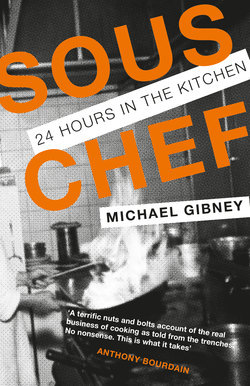Читать книгу Sous Chef - Michael Gibney J. - Страница 9
На сайте Литреса книга снята с продажи.
PREFACE
ОглавлениеON A WARM AFTERNOON IN THE SPRING OF 2011, I FOUND myself on a shady corner of Forty-Third Street, just off Times Square, smoking one last cigarette before returning to the twentieth floor of the Condé Nast building to complete the second half of my day clipping magazine articles for The New Yorker’s editorial library—a temporary gig I’d taken between kitchen jobs. I was about to chuck the butt into the gutter when, out of the corner of my eye, I spotted a figure whose large silhouette seemed familiar enough to warrant a second look.
He was a tall man—at least six foot three—with a nest of unattended curls atop his head that made him appear even taller. He stood with his back to me, a navy-blue pin-striped suit hanging loosely over his broad shoulders. He puffed at a cigarette and chatted on his phone, making lively gestures with his free hand while a nimbus of smoke collected in the air around him.
Even though I couldn’t see his face, there was something about his posture that I recognized immediately. He was poised, yet oddly stooped at the same time. His movements were quick and fitful, yet marked by a certain calculated, meditative finesse, which could be detected even in something as simple as the way he flicked the ash from his cigarette.
And then my eyes fell on his shoes and it hit me: checker-print slip-on tennies—with a suit, no less. I knew this man: Chef Marco Pierre White.
I lit up another smoke and waited for him to finish his phone conversation so I could say hello.
Of course, I didn’t actually know the man; I only knew of him. I had read his books and I had seen the hoary BBC clips of him preparing noisette d’agneau avec cervelle de veau en crépinette for Albert Roux while a young Gordon Ramsay traipsed around in the background trying to make his bones. I knew that he was the kitchen’s original “bad boy,” the forerunner of our modern restaurant rock stars. I knew that he was the first British chef (and the youngest at the time—thirty-three) to earn three Michelin stars, and I knew that the culinary world quaked when he decided, at age thirty-eight, to give them all back and hang up his apron. And I knew that in recent years he’d made his way back to the stove, in one form or another, on television and elsewhere. So while I didn’t actually know him, I did know that no matter how gauche it is to descend starstruck upon idols, I couldn’t pass up the opportunity to make his acquaintance.
At first, I was met with the annoyance and reservation one comes to expect when approaching celebrities on the streets of Manhattan. I assume he thought I knew him from television. But once I announced that I was a fellow chef, and mentioned the inspiration I drew as a young cook from his books White Heat and Devil in the Kitchen, he let his guard down and we were able to speak casually. Over the course of five or ten minutes, we talked about the craft of cooking, its values and its drawbacks, and what pursuing it professionally does to the body and mind.
Eventually he had to get going, and I had to return to work as well. I concluded the conversation by asking him how he felt about quitting the industry. He paused dramatically and pulled on his smoke.
“No matter how much time you spend away from the kitchen,” he said, “cooking will always keep calling you back.”
We pitched our butts and parted ways.
I was sixteen years old when I started working in restaurants. I managed to land a job washing pots in an Irish pub owned by a high-school friend’s father. Half an hour into my first shift, the floor manager swept into the kitchen in search of a dishwasher.
“Hey, you,” he said. “Some kid puked in the foyer. I need you to clean it up.”
It was then that I decided I had to become a cook—if only to avoid vomit detail.
More than thirteen years have passed since I made the decision. In that time, I’ve seen all manner of operation—big and small, beautiful and ugly. I’ve climbed the ladder from dishwasher to chef and cooked all the stations in between. The experiences I’ve had along the way have been some of the best ever and some of the worst imaginable. What follows is my attempt to distill these experiences into a manageable, readable form: a day in the life, as I have seen it.
Within these pages, I’ve compiled material from several different restaurants and several different periods in time. I’ve also sometimes modified the names of people and places. In all instances, I’ve done so in service of authenticity and concision. I don’t presume to offer some judgment of the restaurant business as a whole. I only hope to provide a genuine impression of the industry, to throw its nuances into sharper relief, so that when you, the aspiring cook or the master chef, the regular diner or the enthusiastic voyeur, wish to reflect on the craft of cooking, you can do so from a slightly more mindful perspective. I leave it to you to weigh the virtues and vices.
And now to work.
